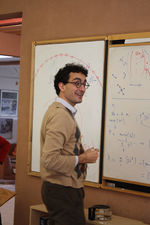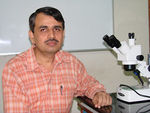Complex Systems Winter School 2015-Faculty
From Santa Fe Institute Events Wiki
Program Director

Somdatta Sinha, Program Director
Lecturers and Faculty

Tanmoy Bhattacharya, Theories and Treatment of Infectious Disease

Liz Bradley, Nonlinear Dynamics
This short course is a wide survey of the field of nonlinear dynamics.

Anirban Chakraborti, Econophysics
Title : Econophysics I - Kinetic exchange models in complex socio-economic systems
Abstract: In this talk, I will review pedagogically the kinetic exchange models whose outcome is the prediction of the wealth distribution in the society. Comparison with empirical data, and the analytical fitting forms for such wealth distributions will be discussed. The micro-economic formulation of such models will be also mentioned, which establishes the link between the principles of maximum entropy in physics and utility maximization in economics. Then I will also briefly review a minimal multi-agent model for the collective dynamics of opinion formation (based on the similar kinetic exchange dynamics studied in the context of wealth distribution), and its simple variants and extensions that have been proposed recently by others.
Title: Econophysics II - Statistical mechanics of competitive resource allocation: El Farol Bar to Kolkata Paise Restaurant
Abstract: Demand outstrips available resources in most situations, which gives rise to competition, interaction and learning. In this talk, I will review a broad spectrum of multi-agent models of competition (El Farol Bar problem, Minority Game, Kolkata Paise Restaurant problem, and others) from the perspective of statistical physicists.

Arkadev Chattopadhyay , Computational Complexity
How much time or space is needed to solve a computational problem? But this should
depend on what machine/platform/technology is used to solve it! Computational complexity
theory provides elegant notion of efficient computation that are independent of the
computer hardware technology. Further, these notions give rise to deep philosophical
questions, such as the following: "Can creativity be automated?"
In these lectures, I plan to cover a few key developments in the field that should be of
importance and interest to all scientific disciplines.

Aaron Clauset, Four Lectures on Network Science
Network science is a thriving cross-disciplinary domain focused on the representation, analysis and modeling of complex social, biological and technological systems as networks or graphs. These four lectures will provide a compact introduction to the modern study of network science. We will examine techniques for analyzing and modeling the structure and dynamics of complex networks, and we will cover a broad selection of the core concepts in the field. Some emphasis will be placed on statistical algorithms and methods, and on model interpretation and real data. Applications will be drawn from computational biology and computational social science.

Simon DeDeo, Cognitive Science and Social Minds
Lectures One and Two: Information Flows
When did the French Revolution become revolutionary? How did pre-20th Century London manage violence? How did Charles Darwin synthesize Victorian science to write the Origin of the Species? Information theory not only plays a central role in physics and engineering. It can also be used to quantify critical features of the human mind and the societies it creates. In these first two lectures, I’ll introduce the core mathematics of information theory, and build intuition about what they mean. Drawing on recent collaborative research with scientists and scholars in the humanities—I’ll present the three case studies described above. I’ll show how information theory in the big data era allows us to get a new picture of the development of human society and, often, a glimpse of the minds—elite and non-elite—of the past and the future. And I’ll show how fundamental mathematical laws of coarse-graining and lossy compression place new constraints on the nature of evolution.
Lectures Three and Four: Social Feedback
From the emergence of the first strands of RNA to the invention of multicellularity, the evolution of life is marked by major transitions. No less so the evolution of our social and cognitive worlds, as they develop from the animal societies we see in television documentaries to the world- and soloar-system-spanning civilizations of the 21st Century. From the first awareness and use of group-level social facts to the emergence of norms and their self-assembly into normative bundles, each transition represents a new relationship between the individual and the group. At the center of this relationship is the use of coarse-grained information gained via lossy compression. I’ll provide key examples of these different stages using high-resolution data on two model systems: the highly-social monk parakeets, and the global community of Wikipedia editors. I’ll present new mathematical tools that you can use to analyse the social world, and connect them to some of the core traditions in the study of complex systems.

Laurent Hebert-Dufresne, Statistical Physics and Complex Networks
We will discuss the increasingly central role of statistical physics in network theory. This will involve going over some standard tools of statistical physics applied to network problems --- for instance the description of growing social networks and the spread of infectious diseases --- and we will see how this different modelling philosophy often provides a unique perspective. In so doing, we will compare the statistical physics approach to the mathematical and computer science approaches to classical graph theory.

Eric Libby Microbial Ecology
My lectures will be an overview of microbial ecology with the intent to generally educate and highlight open areas of research.

Ole Peters, Ergodicity Economics
1 Basic concepts
1.1. Tossing a coin
We start by introducing a simple coin tossing game to illustrate the meaning of the expectation value. The coin tossing game is the multiplicative binomial process, studied e.g. by Redner (1990). A coin is tossed, and on heads the wager increases by 50%, on tails 40% of the wager is lost. The interesting property is that the expectation value of the wager grows exponentially under multiplicative repetition, whereas in the long run wealth shrinks exponentially with probability 1.
This is to motivate the importance of using the appropriate tools – sometimes the expectation value may be meaningful, but in many important situations in economics it is irrelevant and misleading.
1.2 Brownian motion (BM) and Geometric Brownian motion (GBM)
This sets out the basic mathematical model for what follows. Although BM itself is not ergodic, rates of change (over finite time) are ergodic. GBM is not ergodic, nor are rates of change under GBM, exponential growth rates (over finite time) are ergodic.
GBM is a natural null model for many economic processes: self-reproducing quantities, such as money, are multiplicative, and an analogue to the additive Gaussian central limit theorem leads to many multiplicative random models converging to GBM.
The expectation value is an ensemble average. Because of the way ergodicity is broken in GBM, the ensemble average has one meaning and the time average has another. Observing a single realization for a long time reveals a time-average growth rate, whereas observing the average over a large ensemble reveals the growth rate of the expectation value. The precise meaning of the two growth rates will be discussed.
2 Individuals
2.1 Decision theory
Decision theory is re-developed. How should an individual decide whether to take some gamble (the usual way of phrasing decision problems in economics)? We solve typical decision problems (gamble evaluation) by considering the time-average growth rate (or the [time- and ensemble-] average of the ergodic growth rate) under multiplicative dynamics. The construction of an ergodic observable motivates the introduction of a non-linear function that encodes the dynamics. This function is historically called the “utility function”.
2.2 The St Petersburg paradox
The classic St Petersburg paradox, in which people are observed to decline a gamble with a diverging expected value, is resolved using time averages. The expectation value is irrelevant for an individual making decisions. Assuming multiplicative repetitions, the relevant (ergodic) observable is the exponential growth rate. This behaves fundamentally differently from the expectation value and does not diverge for the St Petersburg game.
2.3 Insurance
The insurance problem is resolved. In classical economics insurance poses a puzzle: the insurer has to charge at least as much as the expected loss for an insurance contract, whereas the insurance buyer shouldn’t pay more than the expected loss. Hence there is no price at which both parties should sign. Classical economics resolves the problem by introducing psychological arguments of risk aversion, encoded in utility functions. Insurer and insurance buyer are treated separately. We resolve the problem by computing time average growth rates for both parties. A range of prices for the contract is identified that increases the time average growth rates of both parties – under the far-from equilibrium model of GBM a win-win situation exists for a range of mutually beneficial prices.
3 Populations
3.1 Every man for himself
Individual wealth dynamics are modeled as GBM. This implies dynamics for the distribution of wealth. Without interaction between individuals, the distribution of relative wealth (proportions of total wealth) broadens indefinitely, with wealth condensing into the hands of a small minority.
3.2 Cooperation
Interaction between individuals can be beneficial. This was anticipated in the insurance problem: if the wealths of two individuals follow GBM, the individuals can both do better by pooling and sharing resources periodically. Both individuals will experience larger (time-average) growth rates because of a reduction of the noise amplitude that tends to diminish wealth under GBM. In this sense, cooperation is beneficial (again, this is unclear from the perspective of current mainstream economic theory).
3.3 Taxation
A centrally organized form of cooperation as defined above (the periodic pooling and sharing of resources) is taxation. Simple stochastic models of a population that pools and redistributes a proportion of wealth or income reveal the following deep insight: a critical taxation rate exists. Below the critical level inequality increases indefinitely (wealth condensation). Above the critical taxation rate the wealth distribution stabilizes in the long-time limit. This is demonstrated by solving for the moments of SDEs similar to GBM.
4 Markets
4.1 Optimal leverage for stock market investments
GBM is a popular model for stock price dynamics. The following question arises: if an investor can choose how much of his (risk-free) money to invest in a GBM process, what is the optimum proportion? Considering expectation values there is no optimum – the investor should borrow as much as he can and invest everything in the stock market. This inevitably leads to bankruptcy as fluctuations diverge. Considering the time average growth rate, an optimum exists. Fitting the GBM model to real stock market data, the optimal leverage is found to be close to 1.
4.2 Stochastic market efficiency
A stability argument suggests that optimal leverage close to 1 is no coincidence. If it were larger, it would be optimal – for any investor – to borrow and leverage up. But this cannot be done by all investors because someone has to provide the funds. A market environment with optimal leverage greater than 1 is identified as unstable, a bubble in the making. The converse is true for optimal leverage below zero. Good economic policy and other dynamical factors would lead to optimal leverage being 1. This is akin to all resources being productively deployed.
4.3 Solving the equity premium puzzle
A persistent problem in economics is determining the equity premium. This is the difference in the drift term of a risky asset (e.g. the stock market) and the drift term of a risk-free asset (e.g. government bonds). It is known that such a difference exists, but no reasonable theory exists for determining its magnitude. The problem was first pointed out by Mehra and (economics Nobel Laureate) Prescott in 1985. It stands as one of the most significant unresolved puzzles in asset pricing and modern economics. Assuming Stochastic Market Efficiency, the solution of the puzzle is simple. An expression for optimal leverage was derived in 4.1. Setting this expression equal to 1, in accordance with 4.2, produces a simple expression for the equity premium in terms of market volatility.

Eleanor Power Social theory, social complexity, and social networks
What happens when our complex systems involve actors that are not cellular automatons or microbes, but conscious, reflective humans? when they have some awareness of what the outcomes of their actions might be, a sense of their position relative to others, and a representation of the larger social entities of which they are a part? In order to understand human social complexity, we need to understand something about how humans operate. To that end, we will first go over some of the fundamentals of social theory, looking at how various theorists have understood how individual action both shapes, and is shaped by, social structure. Having understood some of the critical dynamics of social interaction, in lecture two we will grapple with perhaps a more fundamental topic: the emergence of human social complexity. How can we explain the origins of sedentism? the domestication of plants and animals? the development of social and political institutions (marriage, kinship, religion, property rights)? the advent of state society? This will have us turn to the archaeological record to study some of the crucial transitions in human history. In the final lecture, we will discuss some of the contemporary approaches to these questions of social complexity. We will focus in particular on one of the most promising methodological tools being used today: social network analysis. Focusing on some examples of current scholarship, we will see how some of these fundamental questions of human sociality and complexity are shaped into meaningful, and feasible, research questions.

Rajiv Sethi, Agent-Based Computational Economics
These lectures will provide an introduction to agent-based computational modeling, drawing on applications in economics and finance. The first lecture will focus on the manner in which decentralized, uncoordinated choices can give rise to emergent properties such as residential segregation. The second and third lectures will examine financial markets, with a focus on how asset price dynamics depend on the composition of trading strategies, and how the composition of strategies itself evolves under pressure of differential profitability.

L S Shashidhara, Development of body plan
During development, relatively simple single-cellular embryo grows into a complex multicellular organism. The emergence of complexity is the result of a series of hierarchical events. I will discuss few simple rules that set developmental patterns during animal development. Built on these foundations, are the changes that have lead to the evolution of multiple forms.

Sitabhra Sinha, Complexity in physiological systems
Patterns of life and death: Complex spatio-temporal dynamics in nonlinear biological systems
Sitabhra Sinha
The Institute of Mathematical Sciences, CIT Campus, Taramani, Chennai
600113, India
E-mail: sitabhra@imsc.res.in
URL: http://www.imsc.res.in/~sitabhra/
Abstract:
Spatially coherent waves of activity are critical for the proper
functioning of different biological organs, in particular, the heart
and the pregnant uterus. In the uterine system, physiological changes
that are not yet well-understood take place through the course of
pregnancy that eventually lead initially transient excitations to give
way to system-wide macroscopic contractions immediately preceding
birth. Using models that include excitable and passive cells, we are
trying to understand the mechanism that results in these dynamical
transitions.
REFERENCES:
R. Singh, J. Xu, N. G. Garnier, A. Pumir and S. Sinha, "Self-organized
transition to coherent activity in disordered media", Phys. Rev. Lett.
108 (2012) 068102.
Physics of the Heart: Controlling nonlinear waves during cardiac arrhythmia
Sitabhra Sinha
The Institute of Mathematical Sciences, CIT Campus, Taramani, Chennai
600113, India
E-mail: sitabhra@imsc.res.in
URL: http://www.imsc.res.in/~sitabhra/
Abstract:
The heart, one of the most vital organs of the human body, has to have
regular contractions under normal circumstances - any disruption of
the natural rhythm can lead to one of several types of arrhythmia,
some of which can be potentially fatal. Spiral waves and their
subsequent breakup into spatiotemporal chaos have been associated with
certain life-threatening arrhythmia, such as ventricular tachycardia
and fibrillation. Currently most effective therapies for such cardiac
disorders involve applying large electrical shocks that have damaging
side-effects. We are trying to develop more efficient chaos-control
based strategies for terminating arrhythmia by studying the role of
sub-threshold stimulation and tissue heterogeneities (such as
inexcitable obstacles and excitability gradients) on the dynamics of
spiral waves and spiral chaos states.
REFERENCES:
S. Sridhar et al, "Suppression of cardiac alternans by alternating-period-
feedback stimulations", Phys Rev E 87 (2013) 042712.
S. Sridhar and S. Sinha, "Response to sub-threshold stimulus is
enhanced by spatially heterogeneous activity", Europhys. Lett. 92
(2010) 60006.
S. Sridhar and S. Sinha, "Controlling spatiotemporal chaos in excitable
media using an array of control points", Europhys. Lett. 81 (2008) 50002
S. Sinha, A. Pande and R. Pandit, "Defibrillation via the elimination of spiral
turbulence in a model for ventricular fibrillation", Phys. Rev. Lett.
86 (2001) 3678

Andreas Wagner, Evolution and genotype networks
After a brief survey of important milestones in the history of evolutionary biology, these lectures will turn to the most fundamental problem of the field, namely how evolution creates new and beneficial features of organisms. This “innovation problem” has recently been tackled in different classes of complex molecular systems, including chemical reaction networks in metabolism, regulatory gene circuits, as well as protein and RNA macromolecules. I will discuss these efforts, the progress that has been made, and introduce the important role genotype networks play for innovation in all these systems. I will also touch upon other important tensions in modern evolutionary biology that relate to the innovation question, such as that between neutral and selected change, as well as that between a system’s robustness and its innovation ability. Time permitting, I will also discuss how recent insights into the innovation problem in biology could apply to technological evolution.
Staff

Juniper Lovato, Director of Education, Santa Fe Institute

